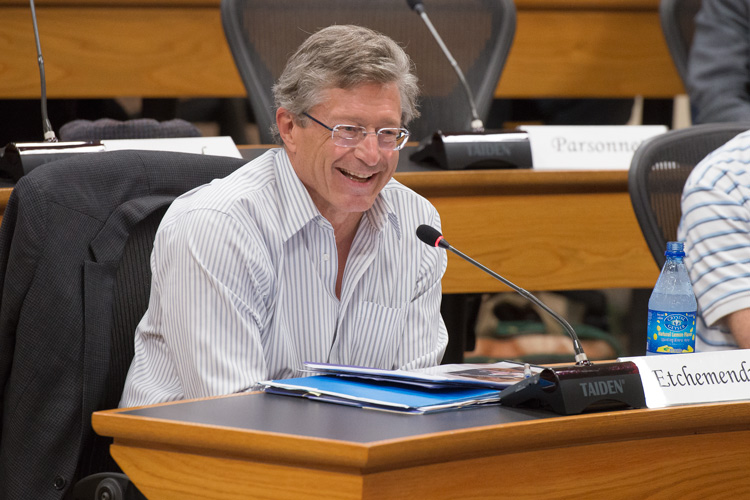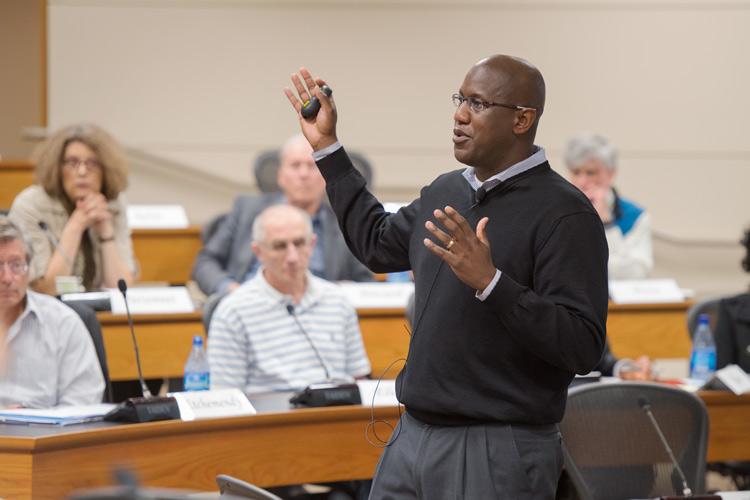Stanford forms new Office of the Vice Provost for Teaching and Learning
By combining resources of the Center for Teaching and Learning, parts of Academic Computing Services, the CourseWork engineering team and the Office of the Vice Provost for Online Learning, the new organization will provide better coordination between groups that support teaching, learning and reaching learners online.
At Thursday's Faculty Senate meeting, Provost John Etchemendy announced that Stanford will combine several organizations now scattered across campus to establish the Office of the Vice Provost for Teaching and Learning.

Provost John Etchemendy talking to the Faculty Senate about the newly created Office of the Vice Provost for Teaching and Learning.
The senate meeting also included presentations on a faculty survey on undergraduate teaching and on Stanford Athletics.
The new office, which will be formed in the coming months, will combine the resources of the Center for Teaching and Learning, the portions of Academic Computing Services aimed at teaching and learning, the CourseWork engineering team and the Office of the Vice Provost for Online Learning.
"We are consolidating these activities into a single unit in order to lessen confusion, so that faculty, graduate students and undergraduates all know where to go when they are interested in either receiving assistance in their teaching and learning, or want to develop innovations in their classrooms," Etchemendy said.
The new organization will continue to offer all the services each group now provides to faculty, students and staff.
John Mitchell, currently the vice provost for online learning and a professor of computer science, will lead the new office.
Etchemendy said a task force of senior leaders – Harry J. Elam Jr., vice provost for undergraduate education; Patricia Gumport, vice provost for graduate education; University Librarian Michael Keller; and Karen Cook, vice provost for faculty development and diversity – recommended combining the groups, after surveying campus resources supporting faculty teaching, the use of instructional technologies and student learning activities.
The four groups share common interests and provide related services to Stanford in complementary ways:
The Center for Teaching and Learning, which is located in Sweet Hall, offers many services, including consulting with faculty and their departments on course design, teaching strategies and course evaluation, training teaching assistants, and coaching undergraduate and graduate students on time-management and study skills.
Academic Computing Services, which is located in Lathrop Library, provides technology resources and tools for teaching, learning and research to faculty, students and staff. Its services include discipline-focused and general consulting for faculty on technology for teaching, research and digital humanities scholarship.
CourseWork, which is part of Academic Computing Services, is Stanford's learning management system and is mainly used by instructors to create websites for their courses. A variety of campus groups also have used CourseWork to manage and conduct project-based activities.
The Office of the Vice Provost for Online Learning (VPOL), which was established in 2012, advances faculty-driven online learning initiatives and research, and provides exceptional educational opportunities to Stanford students by transforming the way learning is organized in campus classrooms and far beyond them.
VPOL collaborates with other educational organizations by sharing course material, data-driven research and source code for enhancements to OpenEdX, its open-source platform for online courses. VPOL also offers courses to lifelong learners around the world through Stanford Online.
Mitchell said the new office will provide better coordination between groups that support teaching, learning and reaching learners online. He said the office will lead a more concerted effort to:
- Support innovation in teaching and learning on campus;
- Use digital technology to make Stanford research and scholarship more broadly accessible beyond campus; and
- Support the growing interest in extended programs, such as the Stanford University Online High School and the Stanford Center for Professional Development, which provide meaningful educational opportunities to additional audiences.
Following the senate meeting, Mitchell said there is tremendous excitement among staff about joining a growing organization.
"We're already working together in many, many ways, so this organizational change simplifies things we're already doing," he said.
"There are such striking overlaps I think we will see improvements immediately. For example, the teaching experts in the Center for Teaching and Learning will be able to work much more easily and effectively with instructional designers now working in VPOL and with academic technology specialists coming from Academic Computing Services. We are connecting the teams that work on CourseWork software for on-campus teaching and the Stanford OpenEdX platform that allows external delivery of online courses. I've seen a lot of enthusiasm for that from the engineers who now have many more colleagues to talk to."
Issues facing intercollegiate athletics
In his address to the senate, Bernard Muir, director of athletics, physical education and recreation, discussed new challenges and pending lawsuits that could change the face of college athletics.

Bernard Muir, director of athletics, physical education and recreation, addressing the Faculty Senate on Thursday.
Muir sits on an intercollegiate subcommittee studying football recruiting. He said some members of the subcommittee believe high school students should have to decide which college they're going to before their senior year.
"That doesn't please David Shaw [Stanford football coach], Dean [Richard] Shaw [dean of admission and financial aid], other faculty members, other campus leaders, other coaches, because all of a sudden students are deciding, in some cases even before they learn how to drive, which college they're going to attend. That's a real concern for us."
Muir mentioned that the number of lawsuits being filed nationally by student athletes, most of which seek compensation and benefits that would equate student athletes with employees, have risen over the past year from two to more than 10. Those lawsuits threaten to undermine the amateur aspect of college athletics, particularly challenges that would consider athletic scholarships to be compensation.
He suggested a scenario where student athletes barter for compensation packages and perks, akin to professional athletes. If such actions were taken, Muir said, Stanford would likely withdraw from competition and many colleges and universities could not afford to compete.
Muir discussed some of the reforms the Pac-12 Conference adopted last year to provide additional support to student-athletes, including a provision that allows schools to spend as much as they want on meals. Student-athletes eat quite a bit, he said.
"We thought we were doing a wonderful thing; we have invested $250,000 in meals, primarily snacks," he said. "When they leave your classrooms and they're getting ready to go over to practice, they can grab a smoothie, they can grab a granola bar."
But at a recent Pac-12 Conference meeting, Muir found out that one university was putting $600,000 into meals and another was investing $1.5 million.
"Now I'm not sure what they're feeding them," he said. "It could be steak and lobster. But now there's an arms race in meals."
Muir said one of the key reforms instituted by the Pac-12 Conference was lifetime scholarships for student-athletes who leave school before graduating and want to return. He said that isn't such an issue for Stanford because of its high – 97 percent – student-athlete graduation rate, and Stanford offers aid to athletes to continue their education if for some reason they are unable to compete.
Muir said concussions among student-athletes are another issue of utmost importance to Stanford Athletics.
"Thank goodness we're doing a lot of research with Stanford Medicine on our football student-athletes primarily, but also in the sports of soccer and women's lacrosse," he said, adding that Stanford Athletics is studying how students get concussions and how to prevent them in the future.
He said Stanford's athletic training staff and its team doctors are much more cautious about having a student-athlete return to play after a concussion.
During his presentation, Muir referred to "Game Changer," an article on the future of Stanford's athletic program in the September/October issue of Stanford magazine. Copies of the magazine were available for senators at the meeting.
Muir also showed "It's on Us," a 2-minute video of student-athletes talking about how the Stanford community must take responsibility for preventing sexual assaults on campus. The video is part of a national campaign, launched by President Obama in September, to end sexual assaults on college campuses.
The full minutes of the Dec. 4 meeting will be available on the Faculty Senate website next week. The minutes will include the question-and-answer session that followed the presentations. The next senate meeting will be held Jan. 22.

Share This Story